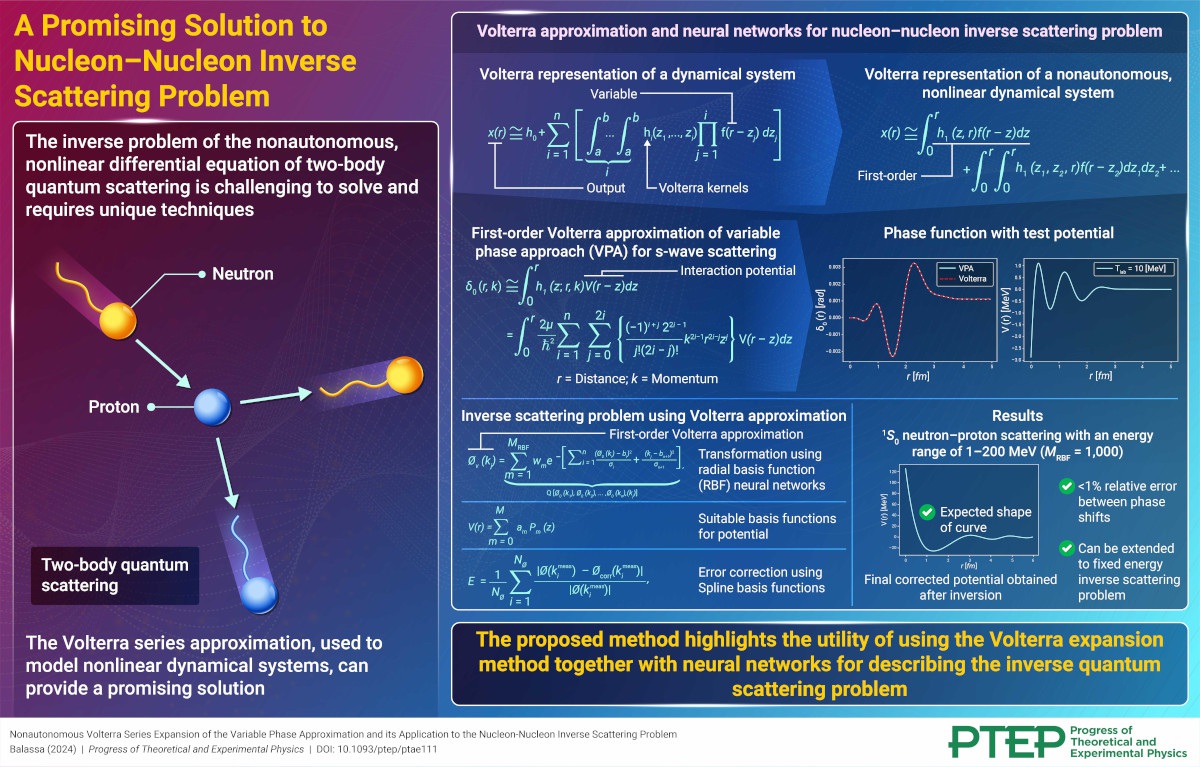A Promising Solution to Nucleon–Nucleon Inverse Scattering Problem
© The Physical Society of Japan
This article is on
Non-autonomous Volterra series expansion of the Variable Phase Approximation and its application to the nucleon-nucleon inverse scattering problem
(PTEP Editors' Choice)
Prog. Theor. Exp. Phys. 2024, 083A01 (2024).
This study deals with the inverse elastic two-body quantum scattering problem using Volterra approximations and neural networks, offering a novel approach for solving complex nonlinear systems.

Linear or nonlinear dynamical models can explain various real-life phenomena. While linear approximations work well for some systems, others can only be explained by nonlinear models, which greatly complicates calculations. One such phenomenon is the elastic two-body quantum scattering of nucleons.
This scattering problem is described by the Variable Phase Approximation (VPA), a nonautonomous nonlinear differential equation. The inverse nuclear scattering problem, where the interaction potential is determined from the asymptotic phase shifts at different energies or angular momenta, is particularly difficult to solve due to its sensitivity and ill-conditioned nature.
While several approaches exist to solve this problem, none can perfectly identify the interaction potential without prior knowledge of the system and each approach gives slightly different results. In this study, researchers attempt to address this problem by utilizing the Volterra series expansion and incorporating neural networks to deal with the inverse scattering problem.
First, they describe the forward VPA problem using the Volterra expansion. Due to the nonautonomous nature of VPA, the original Volterra method had to be extended, resulting in a first-order Volterra model for s-wave scattering. This model offers a robust approximation over a wide operating range with potentials up to a few tens of Mega electronvolts (MeV).
However, in practical neutron scattering experiments where the potentials are larger, the first-order approximation alone is insufficient, necessitating higher-order terms to capture the remaining error. Instead of introducing higher-order terms, in this study, the researchers modeled the remaining error as a nonlinear noise term using radial basis function (RBF) neural networks. This allowed the system to still be described by the first-order Volterra model.
By expanding the interaction potential term with suitable polynomials containing unknown coefficients, the RBF-transformed model could be written as a system of linear equations, which can be easily solved. Finally, at the last stage, Spline basis functions were applied to weed out the remaining errors through small continuous changes in the potentials.
This model was applied to 1S0 neutron-proton scattering at fixed angular momentum within the 1 to 200 MeV energy range, yielding accurate results with expected potentials and less than 1% averaged relative error in the phase shifts. This method is also versatile enough to be applied to nuclear scatterings at fixed energy.
In summary, this study represents a significant advancement in nonlinear modeling. Beyond physics, this method can also be applied in other fields, such as biology and aerospace engineering. Moreover, it offers a way to gain deeper insights into nonlinear problems in physics, both in theory and in experiments.
Non-autonomous Volterra series expansion of the Variable Phase Approximation and its application to the nucleon-nucleon inverse scattering problem
(PTEP Editors' Choice)
Prog. Theor. Exp. Phys. 2024, 083A01 (2024).
Share this topic
Fields
Related Articles
-
A New Method for Finding Bound States in the Continuum
Mathematical methods, classical and quantum physics, relativity, gravitation, numerical simulation, computational modeling
Nuclear physics
2024-10-1
This study presents a general theory for constructing potentials supporting bound states in the continuum, offering a method for identifying such states in real quantum systems.
-
General Quasi-Joint Probabilities on Finite-State Quantum Systems
Mathematical methods, classical and quantum physics, relativity, gravitation, numerical simulation, computational modeling
2024-8-15
This study investigates the properties of general quasi-joint probability distributions in finite-state quantum systems, revealing the Kirkwood-Dirac distribution as among the most favorable. This highlights the importance of complex distributions in understanding quantum probability.
-
Solving a Stochastic Differential Equation is Solving a Mean-Field Quantum Spin System
Statistical physics and thermodynamics
Mathematical methods, classical and quantum physics, relativity, gravitation, numerical simulation, computational modeling
Magnetic properties in condensed matter
2024-5-16
The replica method maps matrix-valued geometric Brownian motion to a mean-field quantum spin system. This correspondence makes it possible to obtain an exact solution for matrix-valued geometric Brownian motion.
-
Quantum Mechanics of One-Dimensional Three-Body Contact Interactions
Mathematical methods, classical and quantum physics, relativity, gravitation, numerical simulation, computational modeling
Theoretical Particle Physics
2024-2-13
The quantum mechanical description of topologically nontrivial three-body contact interactions in one dimension is not well understood. This study explores the Hamiltonian description of these interactions using the path-integral formalism.
-
Exploring Recent Advances in the Physics of Biofluid Locomotion
Measurement, instrumentation, and techniques
Cross-disciplinary physics and related areas of science and technology
Electromagnetism, optics, acoustics, heat transfer, and classical and fluid mechanics
Statistical physics and thermodynamics
Mathematical methods, classical and quantum physics, relativity, gravitation, numerical simulation, computational modeling
Structure and mechanical and thermal properties in condensed matter
2023-12-8
This Special Topics Edition of the JPSJ describes the latest advances in the field of biofluid locomotion, shedding light on the underlying physics behind the movement of organisms that swim and fly.
